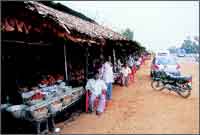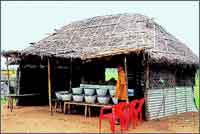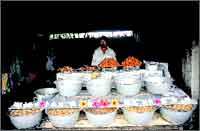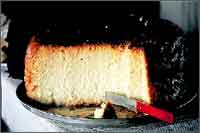


|
|
|
ON Orissa�s National Highway No. 5, some 12 kilometres between Bhubaneshwar and Cuttack, is a village called Pahala in which reside the champion sweetmeat-makers of the state. They are known as halwais and for a living these men make and sell their sweets in a small little bypass just off the highway. It is known to everybody using the highway as the Kalinga Sweet Market. Every motorist, every trucker, every two-wheeler rider must pull off the highway and come to a stop before one of the sweet stalls. First, everybody satiates himself by sitting on a wooden bench inside one of the stalls and eating to his heart�s content. Then parcels are packed and taken away for the people at home. The Kalinga Sweet Market is a must-stop halt on the NH5, almost like a petrol pump where you would fill your car before starting off on a long journey into the next state.
Not that there is much to choose from and taste in the Kalinga Sweet Market. For only three varieties of Oriya sweets are sold here. The Rasgulla, the Chennagaja and the Chennapoda. These are the specialities of the halwais of the Pahala village. Some 25, 30 stalls selling the same three sweets in a small bypass of 100 metres! Inquiries with the halwais show that they do know how to make other sweets as well, but they won�t do so. �Why should we bother,� asks one indignantly, �when the Rasgulla, Chennagaja and Chennapoda are our specialities? People come all the way here just for this!� It is true. These sweets are their specialities. And the halwais sit there from early in the morning, say 6 o�clock, and work till midnight, making the sweets in huge cauldrons of sugar syrup over which buzz a thousand flies and selling their entire stock before winding up.
The other two sweets are also chenna based. The Chennagaja is a mixture of the chenna and sooji again. But this dough is dried after the water is squeezed out of it. It is then cut and shaped and deep-fried in sugar syrup. It tastes as unlike rasgulla as possible, though the ingredients that go in the making are the same, and the Chennagaja has a shelflife of upto ten days. It sells for Rs. 2 a piece. Whereas the Chennapoda, though chenna and sooji again, with little elaichi and sugar, is wrapped in the leaves of the Sal tree and then baked in a charcoal oven for upto four hours. Red hot coal is put on top of the dough too, so that the Chennapoda develops a crust. The Sal tree leaves are used as a binder. Oriyas often use these leaves to eat upon when banana leaves are not available. After four hours when the Chennapoda is ready, it looks like a big dish of caramel custard. Indeed, it can be sliced into pieces like a fairly well-set custard. It has a shelflife of five days and sells at Rs. 50 a kilo.
|

Home Page
About the mag
Subscribe
Advertise
Contact Us
 The Sweet Bypass On NH5
The Sweet Bypass On NH5
 The sweet stalls look alike. They all stand together in a row, small sheds with no walls, doors and windows, and with thatched roofs on top. A photo-frame of some god will be nailed onto one of the beams that keeps the roof up. And they all sell the same sweets, too. At the same rates. Moreover, while you might imagine that competition is fierce and even cut-throat here, a kind of easy camaraderie exists between the halwais. There�s no jealously and heartburn among them. Nor is their a brisk sales pitch to attract customers. The sweets are laid out in the open on shelves in the stalls. You can stop before any halwai and make your purchase. The neighbouring stall-owner will not try to lure you away with a bargain or by running down the place you are patronising. That�s because in Pahala village, they live as neighbours. Or they are
related and all belonging to the same family. Amazingly, their sweets all taste the same too.
The sweet stalls look alike. They all stand together in a row, small sheds with no walls, doors and windows, and with thatched roofs on top. A photo-frame of some god will be nailed onto one of the beams that keeps the roof up. And they all sell the same sweets, too. At the same rates. Moreover, while you might imagine that competition is fierce and even cut-throat here, a kind of easy camaraderie exists between the halwais. There�s no jealously and heartburn among them. Nor is their a brisk sales pitch to attract customers. The sweets are laid out in the open on shelves in the stalls. You can stop before any halwai and make your purchase. The neighbouring stall-owner will not try to lure you away with a bargain or by running down the place you are patronising. That�s because in Pahala village, they live as neighbours. Or they are
related and all belonging to the same family. Amazingly, their sweets all taste the same too. Next morning, it is the same routine. The Rasgullas come in five sizes. These are not the standard, rubbery rasogollas of Haldirams, K. C. Das, Sen Mahasey and Gongurams in neighbouring Kolkatta. These are a softer version, more creamish in colour than white, and not as spongy as the Bengali�s rasogolla for sure. The Pahala halwais allege that one reason why the Bengali rasogolla is tougher than theirs, is that the Bengalis want a longer shelflife for their product. They add arrowroot powder to their rasogullas. In Pahala, they mix 25 gms of sooji with 1 kg of chenna (cottage cheese) in the making of their rasgulla. To this is added elaichi for flavour. A dough is made, it is rolled into little balls, and deep fried in sugar syrup. The sooji is used to hold the chenna together in the deep-frying stage. The Pahala rasgullas sell for
Re. 1 to Rs. 5 a piece, depending on the size. They taste divine!
Next morning, it is the same routine. The Rasgullas come in five sizes. These are not the standard, rubbery rasogollas of Haldirams, K. C. Das, Sen Mahasey and Gongurams in neighbouring Kolkatta. These are a softer version, more creamish in colour than white, and not as spongy as the Bengali�s rasogolla for sure. The Pahala halwais allege that one reason why the Bengali rasogolla is tougher than theirs, is that the Bengalis want a longer shelflife for their product. They add arrowroot powder to their rasogullas. In Pahala, they mix 25 gms of sooji with 1 kg of chenna (cottage cheese) in the making of their rasgulla. To this is added elaichi for flavour. A dough is made, it is rolled into little balls, and deep fried in sugar syrup. The sooji is used to hold the chenna together in the deep-frying stage. The Pahala rasgullas sell for
Re. 1 to Rs. 5 a piece, depending on the size. They taste divine! The chenna for these three sweets is made in the Pahala village by the halwais. It is curdled milk from which the curd and whey are separated. The curd is kept in huge vessels and from it, the moisture is squeezed out. This becomes the chenna which is the raw material for hundreds of Bengali sweets as well. Bengalis, who are fond of chenna, believe sweets made out of it are their contribution to the Indian universe of sweetmeats. �Chenna� in Bengali means �child�. And in a way the rosogulla and sandesh, which is another Bengali speciality, are both �children of milk�, the twin pillars of Bengal�s sweet repute. They also make the chamcham, the pantua, dedo, lal doi, ratabdi, jalbhara, manohara, peswari, prabhu bhog, golapi pera and malpua out of chenna. And the rasmalai, described as a Cleopatraesque rasogulla swimming in milk. In comparison, the Oriya halwais of Pahala are happy with their Rasgulla, Chennagaja and Chennapoda. When you bite into any of them, they say, a gentle explosion of flavour fills the mouth.
The chenna for these three sweets is made in the Pahala village by the halwais. It is curdled milk from which the curd and whey are separated. The curd is kept in huge vessels and from it, the moisture is squeezed out. This becomes the chenna which is the raw material for hundreds of Bengali sweets as well. Bengalis, who are fond of chenna, believe sweets made out of it are their contribution to the Indian universe of sweetmeats. �Chenna� in Bengali means �child�. And in a way the rosogulla and sandesh, which is another Bengali speciality, are both �children of milk�, the twin pillars of Bengal�s sweet repute. They also make the chamcham, the pantua, dedo, lal doi, ratabdi, jalbhara, manohara, peswari, prabhu bhog, golapi pera and malpua out of chenna. And the rasmalai, described as a Cleopatraesque rasogulla swimming in milk. In comparison, the Oriya halwais of Pahala are happy with their Rasgulla, Chennagaja and Chennapoda. When you bite into any of them, they say, a gentle explosion of flavour fills the mouth.